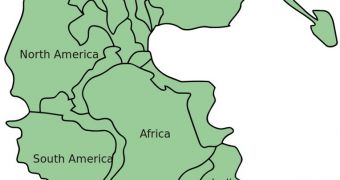Researchers at the China University of Geosciences, in Wuhan, published a new paper in this month's issue of the journal Science China, Earth Sciences, suggesting that the Great Dying – the world's most destructive and widespread extinction event – may have begun some 50 million years before its peak.
Team leaders Dr. Yin Hongfu and Dr. Song Haijun say that the Permian–Triassic (P-T) extinction event is known to have occurred roughly 252 million years ago. During this time, some 70 percent of all land vertebrates went extinct, alongside 96 percent of all marine life.
The P-T event is the only known extinction of insects, with more than 83 percent of all genera and 57 percent of all families disappearing. At some point, there was a real risk that bacteria and other microorganisms will be all that remains of life on this planet. However, some complex species endured.
The cause of this widespread extinction event has been the cause of much debate in the scientific community. Experts only agree on the fact that the P-T event is the boundary between the Permian and Triassic geologic periods, and the Paleozoic and Mesozoic eras, Astrobiology Magazine reports.
For example, the Cretaceous-Paleogene (K-Pg) event that wiped out the dinosaurs and allowed mammals to take control of the planet occurred some 65 million years ago, due to a massive asteroid impact. No such clear cause can be found for the P-T event, which is why the new study is interesting.
Two major volcanic eruptions are known to have played a role in this extinction. Once occurred in southern China around 260 million years ago, and one took place in Russia some 251 million years ago. Both released massive amounts of carbon dioxide and methane, potent greenhouse gases that led to climate change and global warming.
Many marine organisms were killed off by the ensuing ocean acidification process. These events may have been set in motion 50 million years before the peak of the P-T event, at the start of the Permian period 300 million years ago. At that time, the world had a single continent (Pangea) and a single ocean, called Panthalassa.
When the supercontinent formed, its tectonic plates pushed each other deeper and deeper into Earth's mantle. Hongfu and Haijun argue in their new paper that some of the plates may have even reached the planet's outer core, leading to the Illawarra magnetic pole reversal event.
The middle portions of Pangea probably became increasingly arid, killing off countless plant species, while the recession and deepening of Panthalassa may have killed off many shoreline species. But the real driver of the extinction was the material that made its way to the planetary core.
Large mantle plumes may have formed when this happened, through a process known as thermo-convection. The two eruptions, in China and Russia, may have occurred when these plumes finally rose sufficiently to reach the planet's crust.

 14 DAY TRIAL //
14 DAY TRIAL //